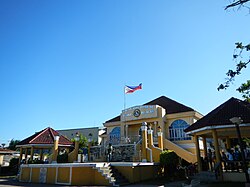Bulakan
|
Bulakan Bulacan |
|||
|---|---|---|---|
| Municipality | |||

Municipal hall
|
|||
|
|||
 Map of Bulacan |
|||
| Location within the Philippines | |||
| Coordinates: 14°47′N 120°52′E / 14.78°N 120.87°ECoordinates: 14°47′N 120°52′E / 14.78°N 120.87°E | |||
| Country | Philippines | ||
| Region | Central Luzon (Region III) | ||
| Province | Bulacan | ||
| District | 1st District | ||
| Founded | 1572 | ||
| Barangays | 14 | ||
| Government | |||
| • Mayor | Patrick Neil F. Meneses (NUP) | ||
| • Vice-Mayor | Alberto G. Bituin (NUP) | ||
| Area | |||
| • Total | 72.90 km2 (28.15 sq mi) | ||
| Highest elevation | 30 m (100 ft) | ||
| Population (2015 census) | |||
| • Total | 76,565 | ||
| • Density | 1,100/km2 (2,700/sq mi) | ||
| • Poverty rate |
|
||
| Time zone | PST (UTC+8) | ||
| ZIP code | 3017 | ||
| IDD : area code | +63 (0)44 | ||
| Income class | 1st class | ||
| Electricity | Manila Electric Company | ||
| • Consumption | 23.71 million kWh (2003) | ||
Bulakan is a first class urban municipality in the province of Bulacan, Philippines. According to the 2015 census, it has a population of 76,565 people. It is 35 kilometres (22 mi) north of Manila.
Bulacan, which is one of the oldest towns in the Philippines, became the encomienda or capital of the Provincia de la Pampanga, and later became the first capital of the Province of Bulacan before it was moved to Malolos shortly after the American occupation. With regards to whether to use the letters "c" or "k" to refer to the municipality of Bulakan, the New Provincial Administrative Code of Bulacan (Ordinance no. C-004) of 2007 states on Chapter 2, Section 15 that the word "Bulakan" stands for the municipality and first capital of the province while "Bulacan" refers to the province itself.
The name "Bulakan" is derived from the Tagalog word "bulak", which means "cotton". The town was named Bulacan due to the abundance of cotton plants growing in the region. The town is one of the oldest in the country.
The Augustinians founded Bulakan as one of the visitas of Convento de Tondo in 1575 under its minister Fray Alonzo Alvarado OSA and in 1578 it became Town Parish and Convent dedicated it under the patronage of Nuestra Señora de la Asunción with Caluya (became town in 1599) and Guiguinto (became town in 1641) as its visitas. According to local records, Father Agustin del Alburqueque, OSA is the first Prior of the Town.
In a census of June 1591, the Provincia of Bulacan had 1,200 tributes or 4,800 persons, one Augustinian convent, One Gobernadorcillo and one Alcalde mayor (present day governor) who had jurisdiction over the Towns of Bulakan (then capital) Malolos,Calumpit,Guiguinto,Caluya,Meycauayan.In the heart of the town stands the centuries-old adobe church of Our Lady of the Assumption (Nuestra Señora de la Asunción). In front of the church stands the municipal hall and a park named "Plaza del Pilar", which is dedicated to Revolutionary General Gregorio del Pilar who hailed from Brgy. San Jose, Bulakan.
The Parish Church of Our Lady of the Assumption, the second oldest Roman Catholic church in the province, and the longest and widest in terms of aisle length and span respectively. It has a baptismal book entry as early as 1578. On the first page of the book, written was the name of the barrio of the town of Bulacan, Bagio, Bulacan (Camino Real), Daan Estacion, Matungao, Cupang, Banban, Dapdap, Parian, Balubad, Pitpitan, Maysantor, Acsajo, Paniqui, San Nicolas, Nagdasig, Calungusan, Taliktik and Sta Ana.
...
Wikipedia



